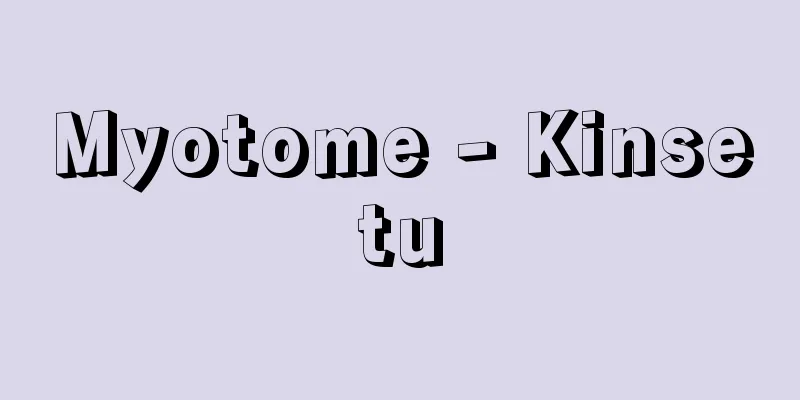Auxin - Auxin

|
A type of plant hormone. A general term for organic compounds that have the same physiological effect as indoleacetic acid, and promotes stem cell elongation, especially at low concentrations. In addition to the natural auxin indoleacetic acid, there are synthetic auxins such as 2,4-D, α-naphthaleneacetic acid, β-naphthoxyacetic acid, and 2,4,6-trichlorobenzoic acid. [Masayuki Katsumi] History of discoveryThe history of auxin research dates back to the research on plant movement by Charles Darwin, famous for his theory of evolution, and his son Francis Darwin. In their book The Power of Movement in Plants (1880), they concluded that the phototropism of the coleoptile of the canary grass is caused by the tip of the coleoptile sensing side light, which transmits some kind of stimulus to the lower part, causing bending there. Later, in 1913, Danish Booysen Jensen discovered that this stimulus was chemical. Hungarian Pál Árpúd (1889-1943) found that when he cut off the tip of a coleoptile of oatmeal and placed it on the cut surface with a shift, bending occurred in the opposite direction to the part on which the tip was placed, even in the dark, and showed that bending was related to a kind of growth substance produced at the tip (1919). Frits Warmolt Went (1903-1990) of the Netherlands used the same material, but placed the cut end on an agar block, and succeeded in diffusing and collecting the substance in the agar (1928). When the agar block was placed offset on the cut end of a coleoptile with the tip removed and placed in the dark, bending was also observed. Since the concentration of growth factors in the agar and the angle of bending of the coleoptile are proportional within a certain range, Went devised a biological test method for auxin based on this principle (Avena bending test). The word auxin comes from the Greek word auxein (to grow), and was named by F. Kögl of the Netherlands in 1931. Substances with auxin activity are widely distributed in the biological kingdom, and Kögl et al. isolated this substance from human urine and found that it was indole acetic acid (1935). It was later discovered that indole acetic acid is a natural auxin present in plants. [Masayuki Katsumi] How it worksIn addition to its main function of promoting cell elongation, auxin also promotes parthenocarpy, fruit growth, and cambium division, and inhibits root and lateral bud growth. The inhibition of lateral bud growth is related to the phenomenon of apical dominance (the phenomenon in which the apical bud inhibits the growth of the lateral buds below it). Auxin is transported downward from the apex of the shoot, but the growth of the lateral buds at the lower part is inhibited by auxin. This is thought to be due to the inhibition of the synthesis of cytokinin (a plant hormone) in the lateral buds, which promotes the growth of lateral buds. When apical dominance is strong, the branching of the plant body becomes weak. Auxin also plays an important role in the formation of adventitious roots, vessel differentiation, and floral organ differentiation. It is not yet clear how auxin exerts these effects, but the following has been clarified regarding its representative effect of promoting cell elongation. The elongation of plant cells is mainly caused by the absorption of water by the cells. Auxin acts on cells to loosen the cell walls and increase their extensibility, allowing them to absorb more water. The mechanism by which auxin loosens the cell walls is understood as follows. This is due to both the action of auxin increasing the secretion of protons (hydrogen ions) from the cell membrane into the cell wall, lowering the pH and activating enzymes in the cell wall involved in loosening, and by promoting the synthesis of new proteins necessary for loosening through new gene expression. Auxin can be synthesized from the amino acid tryptophan through three pathways, but it is unclear which pathway actually works in plants. Also, synthesis other than from tryptophan has been suggested. [Masayuki Katsumi] "Plant Cell Walls" by Masuda Yoshio (1986, University of Tokyo Press)" ▽ "Plant Physiology" by Masuda Yoshio (1988, Baifukan)" ▽ "Plant Hormones" by Kuraishi Susumu (1988, University of Tokyo Press)" ▽ "Life Science Series: Plant Hormones" by Katsumi Masayuki (1991, Shokabo)" ▽ "Illustrated Introduction to Plant Hormones" edited by Masuda Yoshio (1992, Ohmsha)" ▽ "Plant Hormone Handbook, Vol. 1, edited by Takahashi Nobutaka and Masuda Yoshio (1994, Baifukan)" ▽ "The New Science of Plant Hormones" edited by Koshiba Kyoichi and Kamiya Yuji (2002, Kodansha)" [References] | | | | | | | | | |Source: Shogakukan Encyclopedia Nipponica About Encyclopedia Nipponica Information | Legend |
|
植物ホルモンの一種。インドール酢酸と同じ生理作用をもつ有機化合物の総称で、とくに低濃度で茎の細胞伸長を促進する。天然のオーキシンであるインドール酢酸のほかに、2,4-D、α(アルファ)-ナフタレン酢酸、β(ベータ)-ナフトキシ酢酸、2,4,6-トリクロロ安息香酸などの合成オーキシンがある。 [勝見允行] 発見の歴史オーキシン研究の歴史は、進化論で有名なチャールズ・ダーウィンとその息子フランシスFrancis Darwinの植物の運動に関する研究にまでさかのぼる。彼らは『植物の運動の力』(1880)という本のなかで、カナリアソウの子葉鞘(しようしょう)の屈光現象は、子葉鞘の先端が側光を感知し、何かの刺激が下部へ伝えられて、そこで屈曲を引き起こすことによると結論した。その後デンマークのボイセン・イェンセンが、1913年この刺激は化学的なものであることをみつけた。ハンガリーのパール・アルパードPaál Árpúd(1889―1943)はマカラスムギの子葉鞘の先端を切り取って、切り口にずらしてのせると、暗黒中でも、先端をのせた部分とは反対側へ屈曲がおこることをみつけ、屈曲は先端でつくられる一種の成長物質に関係があることを示した(1919)。オランダのウェントFrits Warmolt Went(1903―1990)は同じ材料で、切り取った先端を寒天塊の上にのせて、この物質を寒天中に拡散させて集めることに成功した(1928)。先端を除いた子葉鞘の切り口にこの寒天塊をずらしてのせ、暗黒中に置くと、やはり屈曲がみられた。ウェントは、寒天中に含まれる成長素の濃度と子葉鞘の屈曲の角度は、ある範囲内で比例することから、この原理に基づいてオーキシンの生物試験法を考案した(アベナ屈曲試験)。オーキシンの語源はギリシア語のauxein(成長する)で、オランダのケーグルF. Köglが1931年に名づけた。オーキシン作用をもつ物質は広く生物界に分布し、ケーグルらは人尿からこの物質を単離し、それがインドール酢酸であることを明らかにした(1935)。その後、インドール酢酸が植物体に存在する天然のオーキシンであることがわかった。 [勝見允行] 作用の仕組みオーキシンは細胞伸長を促進する主作用のほかに、単為結実、果実の成長、形成層分裂などを促進し、根の成長、側芽の成長を阻害する。側芽の成長阻害は頂芽優勢の現象(頂芽がその下位の側芽の成長を抑制する現象)とかかわっている。茎頂部からは下方へオーキシンが輸送されるが、下部にある側芽の成長はオーキシンによって抑制される。これは側芽の成長を促すサイトカイニン(植物ホルモン)の側芽における合成が阻害されるためと考えられている。頂芽優勢が強いと植物体の分枝は弱くなる。オーキシンはほかに不定根形成、導管分化、花器官の分化などでも重要な働きをしている。オーキシンがこれらの作用をどのようにしてもたらすのかは、まだはっきりわかっていないが、代表的な作用である細胞伸長促進については、次のようなことが明らかにされている。植物細胞の伸長は、主として細胞の吸水によっておこる。オーキシンは細胞に作用して細胞壁を緩め、その伸展性を増加させることによって、より多くの吸水を可能にする働きをもつということである。またオーキシンによる細胞壁の緩みの機構は次のように理解されている。オーキシンの働きで細胞膜から細胞壁へのプロトン(水素イオン)の分泌が増加し、pH(ペーハー)が低下して緩みに関与する細胞壁の酵素を活性化することと、新たな遺伝子発現によって緩みに必要な新たなタンパク質の合成を促進することの両方による。 オーキシンはアミノ酸の一種であるトリプトファンから三つの経路で合成されうるが、植物体で実際にどの経路が働いているかは確定していない。また、トリプトファンからでない合成も示唆されている。 [勝見允行] 『増田芳雄著『植物の細胞壁』(1986・東京大学出版会)』▽『増田芳雄著『植物生理学』(1988・培風館)』▽『倉石晋著『植物ホルモン』(1988・東京大学出版会)』▽『勝見允行著『生命科学シリーズ 植物のホルモン』(1991・裳華房)』▽『増田芳雄編著『絵とき 植物ホルモン入門』(1992・オーム社)』▽『高橋信孝・増田芳雄編『植物ホルモンハンドブック』上(1994・培風館)』▽『小柴共一・神谷勇治編『新しい植物ホルモンの科学』(2002・講談社)』 [参照項目] | | | | | | | | | |出典 小学館 日本大百科全書(ニッポニカ)日本大百科全書(ニッポニカ)について 情報 | 凡例 |
>>: Oxime - Okishimu (English spelling)
Recommend
Bohdanowicz, B. (English spelling) BohdanowiczB
...Maciej Kamieński's (1734-1821) opera "...
Manguin, HC (English spelling) ManguinHC
… The formation of the group and its techniques b...
Stingray - Akaei
A general term for a family or genus of the order...
Japan Sumo Association
This is a public interest incorporated foundation ...
Kishibojin
(Free translation of Hārītī (Hāri 苫)) [1] In Buddh...
Thread-wrapped sword fittings
…However, the scabbard coating and metal fittings...
The Vicar of Wakefield
A novella by British author O. Goldsmith. Publish...
National Administrative Organization Act - Kokkagyouseisoshikiho
The organizational standards for administrative ag...
Akamata - Akamata
A non-venomous snake of the Colubridae family, or...
Fairy tale play - Douwa Geki
〘 noun 〙 A play adapted from a fairy tale. ※From E...
Right to pursue happiness
One of the fundamental human rights guaranteed in...
Kagura
〘Noun〙 (A variation of " kamukura" ) 1. ...
"Wild Warrior Keaton"
...The pinnacle of his sophistication of gags is ...
Caddisfly (Caddisfly)
A general term for insects in the order Trichopter...
Plant communities
A group of plants of the same or different species...




![Kitahiyama [town] - Kitahiyama](/upload/images/67cb538eae949.webp)




